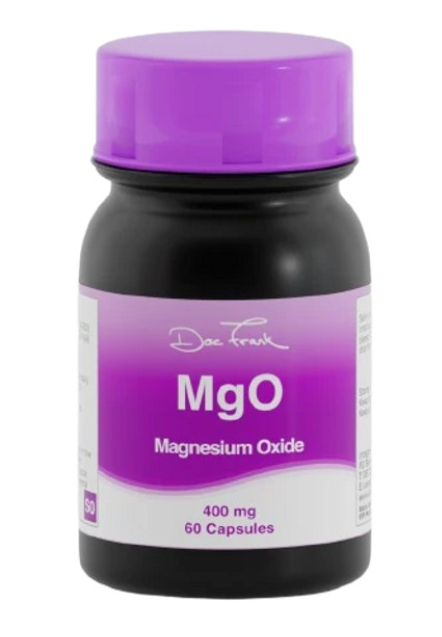Nutribrands-ZA
Magnesium Oxide - MgO (240mg elemental magnesium x 60 Caps @ 1.2 cent per mg)
Magnesium Oxide - MgO (240mg elemental magnesium x 60 Caps @ 1.2 cent per mg)
Couldn't load pickup availability
- Shipping calculated at checkout
- Why are families raving about Nucleo? For nearly 20 years!
South Africa’s Most Cost-Effective Magnesium Supplement
Did you know Magnesium Oxide – MgO is the best-value magnesium supplement in South Africa? Each capsule delivers 240 mg of elemental magnesium—more than any other form, gram for gram, ensuring maximum absorption and benefits for your body.
Why Magnesium Is Essential
Magnesium supports over 300 bodily functions, including muscle and nerve health, bone strength, and blood sugar regulation. Most South Africans are deficient, as modern diets and purified water lack the 600+ mg of elemental magnesium our ancestors absorbed daily from mineral-rich wells. The outdated RDA (300–420 mg) underestimates true needs due to low absorption and losses in stool and sweat.
Key Benefits of Magnesium Oxide - MgO
- Muscles & Bones: Enhances muscle strength, endurance, and bone health; helps prevent osteoporosis and speeds fracture healing.
- Brain & Mood: Improves sleep quality, focus, memory, and calmness while reducing anxiety and migraine frequency.
- Stress & Immunity: Lowers cortisol (stress hormone), boosts GABA (calming hormone), and strengthens immune response.
- Digestion: Neutralizes stomach acid to relieve heartburn and indigestion.
- Bonus: Supports healthy sleep patterns and may alleviate PMS symptoms.
Why Choose MgO 240mg?
- Superior Absorption: Capsules dissolve rapidly in stomach acid, achieving 22.8% bioavailability—comparable to magnesium glycinate (23.5%).
- Enhanced with D-Ribose: Boosts magnesium absorption for a noticeable energy lift within hours.
- Safe & Gentle: Less likely to cause diarrhea compared to other magnesium forms. Excess is safely excreted, preventing overdose.
-
Comparison:
- Magnesium Glycinate (500 mg): 70 mg elemental magnesium
- Magnesium L-Threonate (500 mg): 40 mg elemental magnesium
- Magnesium Citrate (500 mg): 55 mg elemental magnesium
- Magnesium Malate (500 mg): 60 mg elemental magnesium
- Magnesium Oxide (500 mg): 240 mg elemental magnesium
Who Needs Magnesium Oxide?
Perfect for athletes, students, mothers, executives, and the elderly. Supports conditions like depression, insomnia, ADHD, and more. During pregnancy, MgO reduces stress and promotes a calmer baby, supporting brain and bone development.
How Much Magnesium Do You Need?
Two capsules daily (480 mg elemental magnesium) plus dietary sources (e.g., 105 mg from 50 g Nucleo) align with the ancestral intake of ~600 mg. High-performance athletes may safely take up to five capsules daily.
Why Avoid Calcium Supplements?
Unlike magnesium and vitamin D3, calcium supplements don’t improve bone density and may increase mortality risk above 300 mg daily. Focus on magnesium for optimal bone health.
For more on the benefits of Magnesium during pregnancy click here.
For more detailed information on elemental magnesium, you can read the article:
Every body craves MgO!
Share

Much better than any other Magnesium supplement I have used before !
Very good product. Bidy absorbs it well.
